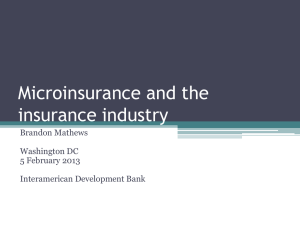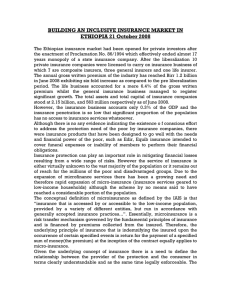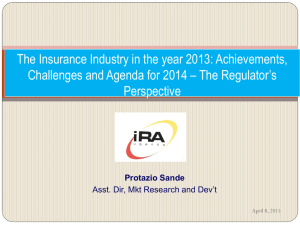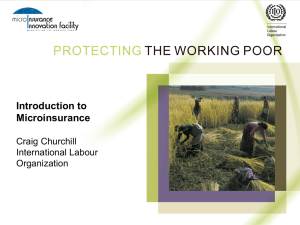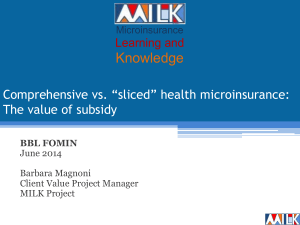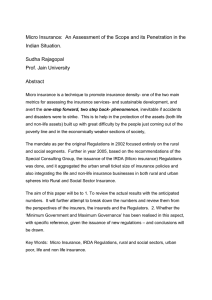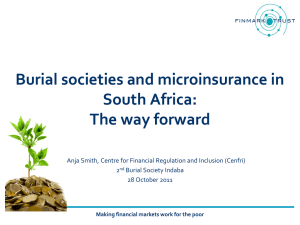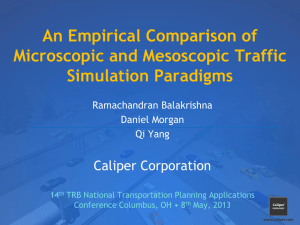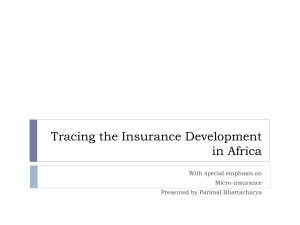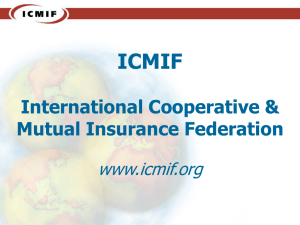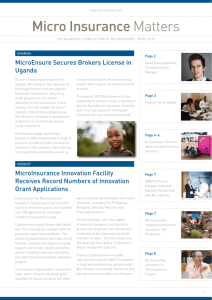36_mWH0B - Foromic 2013
advertisement
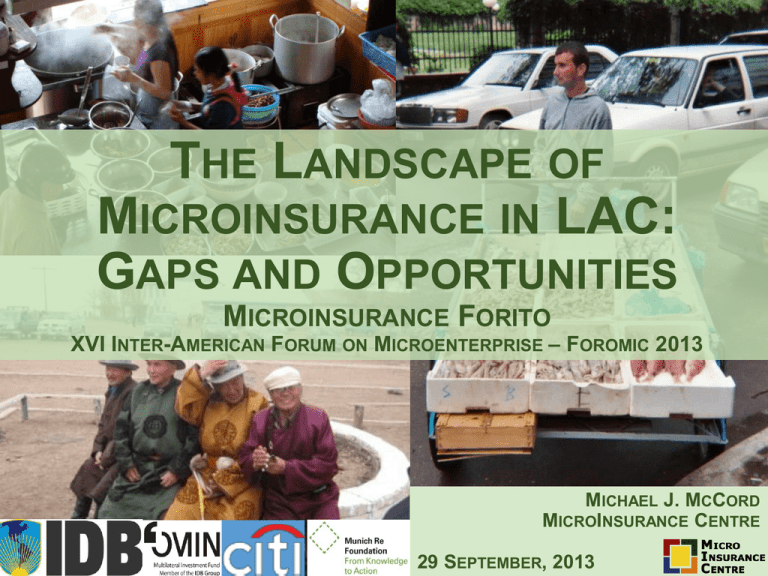
THE LANDSCAPE OF MICROINSURANCE IN LAC: GAPS AND OPPORTUNITIES MICROINSURANCE FORITO XVI INTER-AMERICAN FORUM ON MICROENTERPRISE – FOROMIC 2013 MICHAEL J. MCCORD MICROINSURANCE CENTRE 29 SEPTEMBER, 2013 Microinsurance in LAC 7.6% of the region’s population is covered by microinsurance 7.8% without Brazil and Mexico 2.6% without top five (JM, PE, EC, CO, MX) No. Insured, MM Coverage ratio However, this is primarily by low-value life and personal accident products Need to expand beyond basic products and increase volume of people covered Market could be over 300 million covered with premiums of over USD 6 billion. 2 questions: What gaps in microinsurance development do we see? What opportunities are there for addressing them? Start by identifying various market types… Country allocation by market typology Criteria: macroeconomic, commercial, development, other market issues Characteristics • MI just starting/about to start • Few insurers, maybe one basic product • Often small population Gaps • Know-how • Product development • Actuarial analysis • Voluntary sales • Regulatory support • Working with non-MFI channels • IT, especially back office • Consumer protection Recommendations • Regulation: • Proportional supervision • Meso level: • Technical assistance capacity building • Sharing lessons • Distribution • Enhance capacity • Micro level / private goods: • Paradigm shift facilitation • Institutional structuring for MI The Case of Costa Rica • Characteristics: • Insurance was statecontrolled monopoly until 2008 • First private insurers began sales in 2010 • No MI identified yet • Gaps: • Lack of distribution channels (MFIs reach only 25,000) • Lack of insurer motivation or capacity for microinsurance • Lack of client demand and knowledge Recommendations/ Opportunities – Costa Rica • Regulation: • Learning from other jurisdictions • Meso level: • Leverage REDCAMIF regional network • Distribution • MFI network is looking to partner w/ an insurance broker; pilot in progress • Need creativity in distribution, as MFI outreach is low • Micro level / private goods: • Niche markets: microentrepreneurs and Nicaraguan immigrants • Overcome the ‘brand’ of the state-run company • Characteristics • MI market is driven by MFIs • Limited growth from other distribution channels Gaps • Voluntary sales • Back office and IT capacity • Brokers and intermediaries • Cost accounting and controls • Health covers • Ag covers • Claims assessment technologies • Consumer protection Recommendations • Regulation: • Assess structures in relation to IAIS paper on inclusive insurance • Proportional supervision • Consumer protection strategies • Reduce/eliminate taxes • Meso level: • Capacity building of insurance associations and their institutes • Insurance training institutions • Actuaries and risk tables • Technical assistance capacity building • Develop IT systems • Sharing lessons • Distribution • Coordinate with other regulatory bodies regarding new distribution channels (e.g. mobile service providers) • Enhance capacity of distributors • Micro level / private goods: • Help institutions understand cost structures • Institutional structuring for MI • Paradigm shift facilitation The Case of - Bolivia • Characteristics: 7.23% MI coverage ratio • Vibrant microfinance market • Regulatory requirements of credit market help drive microinsurance • Sophisticated market in terms of risks covered, accessibility, and simplicity • Reasonable MFI commissions (12-18%) • Client protection has evolved • Gaps: • Distribution is concentrated in MFIs, credit-linked products • Lack of affordability for more complex products • Lack of client knowledge/demand outside of MFI network Recommendations Bolivia • Regulation: • Clarify distribution requirements to facilitate alternative distribution • Consider incentives to expand MI market • Meso level: • Market education • Insurance association to take a larger role in MI advocacy • Distribution • Identify and build capacity of alternative distribution channels • Understand costing • Micro level: • Improve capacity of insurers to respond to market needs • Understand costing and risk to improve pricing Characteristics Gaps • Robust middle class • Distinction between traditional insurance and microinsurance is ambiguous • Reaches large numbers of people, but with basic products, some with questionable value • Consumer protection • Regulatory support • Regulatory requirements – policy content • Linkages with mission-led institutions • IT/Back office efficiencies • Cost accounting and controls • Health and ag covers Recommendations • Regulation: • Assess structures in relation to IAIS paper on inclusive insurance • Proportional supervision • Consumer protection strategies • Reduce/eliminate taxes • Meso level: • Capacity building of insurance associations and their institutes • Insurance training institutions • Actuaries and risk tables • Technical assistance capacity building • Develop IT systems • Sharing lessons • Distribution • Clarify legal structures for distribution • Coordinate with other regulatory bodies regarding new distribution channels (e.g. mobile service providers) • Enhance capacity of distributors • Micro level / private goods: • Help institutions understand cost structures The Case of - Brazil • Gaps: 5.36% mi coverage ratio • Limited distribution to poorest populations and rural areas • Little effort made to track product value or social performance • Characteristics: • “Popular” or “mass market” insurance provided mainly by formal commercial insurers • Regulators recently developed “8 Circulares” that address mi • Significant R&D initiatives inform insurers Recommendations – Brazil • Regulation: • Circular implementation • Careful consumer protection • Meso level: • Distribution • Improvement in coverage through MFI/banking agencies • Micro level / private goods: • Development of • Facilitation of technology to innovative, marketimprove efficiencies responsive products • Expansion to rural areas • Enhance linkages with government programs and others that currently reach rural areas Characteristics • Robust and rapidly-growing middle class • Both strong in microfinance and have many “alternate” delivery channels • Multiple strong insurers and channels competing for mi business Gaps • Consumer protection • Regulatory support • Cost accounting and controls • IT • Health and ag covers Recommendations • Regulation: • Assess structures in relation to IAIS paper on inclusive insurance • Proportional supervision • Consumer protection strategies • Reduce/eliminate taxes • Meso level: • Capacity building of insurance associations and their institutes • Actuaries and risk tables • Sharing lessons • Distribution • Clarify legal structures for distribution • Coordinate with other regulatory bodies regarding new distribution channels (e.g. mobile service providers) • Market education: • Develop for specific needs of each market • Monitor effectiveness of market education efforts The Case of - Colombia • Characteristics: 17.23% mi coverage ratio • Vibrant, commercially sustainable market • 25 insurers report MI to FASECOLDA • FASECOLDA provides market education, capacity building, data collection, representation • Exploring alternative channels due to growing cost of distribution through MFIs and utilities • Competition creates tension between profitability and value for clients • Gaps: • 2 major channels (MFIs and utilities) are nearly tapped out • High commissions erode value • Lack of high value products and high value innovation Recommendations – Colombia • Regulation: • Consider impact on MI implications in decision making (ex. In-kind funeral) • Meso level: • Continue to leverage efforts of and share lessons from FASECOLDA • Distribution • Take advantage of existing infrastructure such as call centers • Micro/institutional level: • Shift focus to long-term thinking • Agriculture insurance Opportunities/Recommendations • Further MI development will require both public and private goods • Focusing on the gaps identified for each of the market typologies will have the greatest effect • Key areas for action: • • • • • Legal framework Distribution Market education Meso level capacity / infrastructure Micro / institutional level capacity Microinsurance in Latin America and the Caribbean – the Way Forward • Focus interventions on the Credit-led and Mass market-led country types • Let early microinsurance champions begin to develop and show commitment in Frontier countries before significant interventions are undertaken • Hybrid countries need less intervention but can provide lessons and experience to the rest of the region Growth will continue in the region, but without key interventions, it will continue on the same trajectory of basic products and a push to mass market The MicroInsurance Centre “Developing partnerships to insure the world’s poor” www.MicroInsuranceCentre.org 23 mjmccord@MicroInsuranceCentre.org
